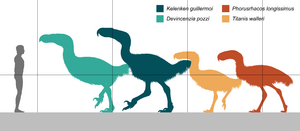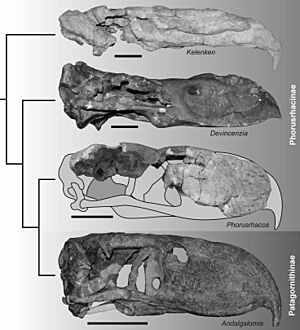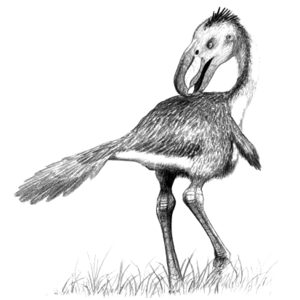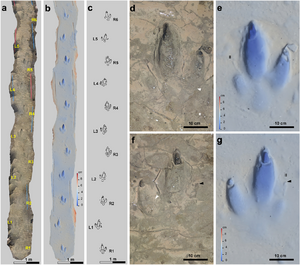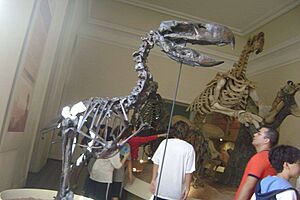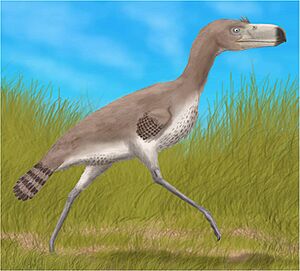Phorusrhacidae facts for kids
Quick facts for kids Phorusrhacidae |
|
|---|---|
 |
|
| Reconstructed skeleton of Titanis walleri, a large terror bird, at the Florida Museum of Natural History. | |
| Scientific classification |
|
| Unrecognized taxon (fix): | Phorusrhacidae |
| Type species | |
| †Phorusrhacos longissimus Ameghino, 1887
|
|
| Subfamilies | |
|
|
| Synonyms | |
|
Family synonymy
Pelecyornidae Ameghino, 1891
Brontornithidae Moreno & Mercerat, 1891 Darwinornithidae Moreno & Mercerat, 1891 Stereornithidae Moreno & Mercerat, 1891 Patagornithidae Mercerat, 1897 Hermosiornidae Rovereto, 1914 Psilopteridae Dolgopol de Saez, 1927 Devincenziidae Kraglievich, 1932 Mesembriorniidae Kraglievich, 1932 |
|
Phorusrhacids, often called terror birds, were a family of huge, meat-eating birds. These birds are now extinct. They were mostly flightless and were some of the biggest apex predators in South America. This was during the Cenozoic era, a long time ago.
Their fossils show they lived from about 43 million years ago to the Late Pleistocene. Some clues suggest they might have appeared even earlier. These birds stood between 1 to 3 meters (3 to 10 feet) tall. One of the largest, found in Uruguay, might have weighed up to 350 kilograms (770 pounds). Today, their closest living relatives are the seriemas, which are much smaller, about 80 centimeters (31 inches) tall.
One famous terror bird, Titanis walleri, lived in Texas and Florida in North America. This makes terror birds the only large South American predators known to have moved north. They crossed a land bridge called the Isthmus of Panama. This event is known as the Great American Interchange. Titanis was an early traveler, moving north about 5 million years ago.
Scientists once thought Titanis died out when humans arrived in North America. However, new studies of Titanis fossils show they disappeared about 1.8 million years ago. This was long before humans were in the area. But, recent discoveries in Uruguay suggest some smaller terror birds, like Psilopterus, lived in South America much later. They might have survived until about 96,040 years ago.
Some scientists have even wondered if terror birds reached Africa and Europe. This idea comes from fossils like Lavocatavis from Algeria and Eleutherornis from France and Switzerland. But these fossils are very broken, so it's hard to be sure. Possible fossils were also found in Antarctica, suggesting they had a wider range long ago.
Similar birds called bathornithids lived in North America. They filled a similar role as predators from the Eocene to Early Miocene epochs. Some, like Paracrax, were as big as the largest terror birds.
Contents
Amazing Features of Terror Birds
Terror birds had a very special neck. It was strong and flexible, helping them carry their heavy heads. This neck could stretch out quickly, allowing them to strike prey with amazing speed and power. Even though their necks looked short, they could extend far. This helped them intimidate prey and deliver powerful blows. The strong neck muscles and heavy head created enough force to seriously injure their prey.
Kelenken guillermoi was a huge terror bird. Its skull, found in Patagonia in 2006, is the largest bird skull ever discovered. This skull was about 71 centimeters (28 inches) long and almost complete. Its beak was about 46 centimeters (18 inches) long and curved like an eagle's beak. While many terror birds were smaller, about 60 to 90 centimeters (2 to 3 feet) tall, Kelenken stood about 3 meters (10 feet) tall. Scientists believe these large terror birds were very fast runners, reaching speeds of up to 48 kilometers per hour (30 mph). They likely competed fiercely with other predators, forcing mammals to hunt in forests instead of open plains.
Terror birds had four toes on each foot. The first toe was small and didn't touch the ground. The other three toes (second, third, and fourth) stayed on the ground. The second toe had a special "sickle claw." This claw was curved and large, like a hook. They likely kept this claw raised off the ground to keep it sharp and prevent damage. This design helped them hold onto prey while running. Modern seriemas have similar feet, but terror birds were even more specialized for hunting. Footprints found in Argentina confirm that terror birds held their sickle claw off the ground, just like some ancient dinosaurs.
How Their Skulls Were Built
For a long time, scientists had ideas about terror bird skulls. They thought they had tall beaks and rounded eye sockets. But there wasn't much proof. Then, new fossils were found in Comallo, Argentina. These skulls showed that terror birds had a triangular shape when viewed from above. Their hooked beak was more than half the length of the skull. The back part of the skull was more compact. The nose openings and other areas near the nose were more square than triangular. These discoveries showed the skull was more rectangular overall. This new information also suggested that these birds might have been faster than first thought.
A skull from a smaller terror bird was also found recently. This fossil showed that the inside of the beak was hollow. It had thin supports, like tiny beams, making it strong. This discovery helps scientists understand how these birds evolved. It also helps them compare terror birds to other animals.
How Terror Birds Lived
All terror birds had a large, hooked beak and a big skull. The bones of their beak were tightly joined. This made the beak very strong when striking forward. This suggests they could cause a lot of damage by pecking. Early studies thought their bite force was weak. This led some to believe they hunted only small prey, like rodents. However, other powerful predators, like saber-toothed cats, also had strong beaks or jaws but weak bites. Later studies showed terror birds actually had much stronger bite forces than first believed.
Some terror birds, like Andalgalornis, were very fast in a straight line. But they were not good at making sharp turns at high speeds. This suggests they were not agile hunters of small, quick prey. Instead, they likely focused on hunting larger animals.
What Terror Birds Ate
Scientists believe all terror birds were meat-eaters. The strong downward curve of their beak tip helped them tear flesh from other animals. Many birds today with similar beaks are also carnivores. CT scans of a terror bird skull showed they couldn't shake their prey from side to side. Instead, they used strong downward force. A scientist named Florentino Ameghino once described fossils that looked like giant owl pellets. These masses contained crushed bones of rodents and other small animals. This suggested terror birds might have swallowed prey whole and then spit out indigestible parts, just like owls. However, these specific fossils were never fully studied or found again. So, it's hard to be certain. But other fossilized pellets from Argentina have also been linked to smaller terror birds.
Family Tree of Terror Birds
The name Phorusrhacidae comes from the genus Phorusrhacos. The name Phorusrhacos comes from Greek words. "Phoros" means bearer or bearing. "Rhakos" means wrinkles, scars, or rents. Scientists have compared terror birds to living birds like seriemas and secretarybirds. But terror birds were much larger, so these comparisons can only tell us so much.
After the extinction of the non-bird dinosaurs, many mammals and some bird groups grew very large. This included terror birds. Terror birds belong to a group called Cariamiformes. The only living members of this group are the two species of seriemas. While terror birds are the largest group within Cariamiformes, their exact relationships are still a bit unclear. This is because many of their fossils are incomplete. Related predatory birds called bathornithids lived in North America. They filled a similar role to terror birds.

Scientists use special diagrams called cladograms to show how animals are related. A 2016 study by paleontologist Gerald Mayr helped us understand these relationships. A more recent study from 2024 suggested that Bathornis (a bathornithid) was closer to seriemas than to terror birds.
|
|||||||||||||||||||||||||||||||
Scientists have divided the terror bird family into 5 subfamilies. These include 13 genera and 22 species. These different species developed over time to fit various roles in their environment.
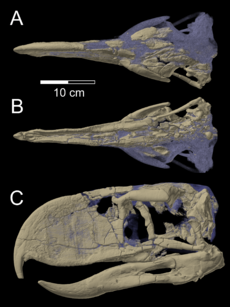
Family Phorusrhacidae
- Incertae sedis (These are genera whose exact placement is uncertain)
- Genus ?Lavocatavis – Found in Algeria (likely not a true terror bird).
- Genus ?Patagorhacos – Found in Argentina.
- Genus ?Paleopsilopterus – Found in Brazil (its identity as a terror bird is doubtful).
- Genus ?Brontornis – Found in Argentina. These were gigantic, standing about 2.6 meters (8.6 feet) tall.
- Genus ?Eleutherornis – Found in France and Switzerland (likely a different type of bird).
- Subfamily Physornithinae — These were large, heavy terror birds.
- Subfamily Phorusrhacinae — These were giant species, up to 3 meters (9.8 feet) tall. They were more slender and agile than Physornithinae.
- Genus Devincenzia – Lived from the Miocene to Early Pliocene.
- Genus Kelenken – Found in Argentina; the largest known terror bird.
- Genus Phorusrhacos – Found in Argentina.
- Genus Titanis – Found in Florida, California, and Texas in North America.
- Subfamily Patagornithinae — These were medium-sized and very nimble, standing around 1.6 meters (5.4 feet) tall.
- Subfamily Psilopterinae — These were small species, standing about 1 meter (3.2 feet) tall.
- Subfamily Mesembriornithinae — These were medium-sized species, standing about 1.3 meters (4.4 feet) tall.
Terror birds are part of a larger group of birds called Australaves. Their closest living relatives are falcons, parrots, and songbirds.
This cladogram shows the relationships among some terror bird groups, based on a 2015 study:
| Phorusrhacidae |
|
||||||||||||||||||||||||||||||||||||||||||||||||||||||||||||||||||||||||||||||||||||||||||
Why Terror Birds Disappeared
During the Miocene and early Pliocene, terror bird populations grew in South America. This suggests they were successful predators in the open grasslands.
About 2.7 million years ago, the Isthmus of Panama formed. This land bridge allowed new predators like dogs, bears, and cats to cross from North America into South America. Some scientists thought this increased competition led to the terror birds' decline and extinction. Similar ideas were considered for other South American predators.
However, some researchers question if competition was the main reason. The timing of when South American predators disappeared doesn't always match when the new large carnivores arrived. Many native predators died out before most of the larger mammal carnivores showed up. For example, Titanis lived in North America for millions of years alongside big cats and dogs. This suggests they could compete successfully. Studies of their bones also show they grew steadily, which is typical for animals in stable environments. This means their extinction might have been due to changes in their environment, not just competition.
Some people once thought humans might have caused the extinction of terror birds. This idea is no longer widely accepted. Better dating of Titanis fossils shows the last large terror birds died out over a million years before humans arrived. However, smaller terror bird fossils have been found in Uruguay. These suggest some smaller types might have survived until about 96,040 years ago. Another possible small terror bird fossil from Uruguay might be even younger, around 17,620 years ago. But this dating is still being debated by scientists.
See also
 In Spanish: Fororrácidos para niños
In Spanish: Fororrácidos para niños


